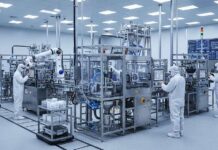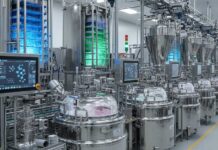It is well to be noted that biopharma production in today’s times takes place in the centralised manufacturing setups. Industry as well as regulators are making sure to have a closer look at the advantages of distributed and decentralised manufacturing, which has in it smaller as well as flexible manufacturing operations in numerous locations that are closer to the site of use and even at the point of care operations.
POC manufacturing happens to be seen as important when it comes to manufacturing personalised medicines. In the short-term future, POC production is most likely to take place in controlled environments like clinics, hospitals, as well as pharmacies, and when it comes to the long term, POC production can very well extend to other locations as well. Such a model can go on to enable the production of quality drugs anywhere, right from a battlefield to a remote village or even, for that matter, in outer space, as per experts.
The focus of POC manufacturing happens to be in parts from its capacity to alleviate pressing issues like shortages of drugs, preparedness regarding pandemics, and also availability when it comes to treatments that are equitable. It also happens to be driven by tech advancements that enable to allow efficient as well as consistent productions that are of high quality by way of using new equipment, quality control features, and analytical tools.
These technologies go on to offer the advantage of making drugs much closer to when and where they are supposed to be. As per Professor Govind Rao from the University of Maryland, Baltimore County, as well as the director of the Centre for Advanced Sensor Technology, the benefits of producing medicines on demand so as to solve issues like difficulty in predicting demand as well as the complexity of the supply chain happen to be compelling.
Notably, the FDA has gone on to recognise the requirement for flexible as well as agile manufacturing and sees the capabilities of portable and also distributed manufacturing units to be used in the case of POC manufacturing. In October last year, the Centre for Drug Evaluation and Research- CDER went on to publish a discussion paper that put forth the areas that need to be considered when it comes to drugs regulated by CDER and also the Centre for Biologics Evaluation and Research and also asked for public feedback. 1
The FDA as well as the Product Quality Research Institute also held a kind of workshop last year to take up inputs when it came to stakeholders. In the case of advanced manufacturing technology, especially distributed manufacturing, AI, POC manufacturing, and also end-to-end continuous manufacturing, looking for input happens to be the first step within the FDA’s new Framework for Regulatory Advanced Manufacturing Evaluation initiative, as per Michael Kopcha, who happens to be the director of pharmaceutical quality in the CDER’s office. 2
The EMA and also the Quality Innovation Group happen to be focused on the same list of advanced manufacturing technologies that got discussed in a focus group meeting 3 in March this year. The decentralised manufacturing happens to be discussed and is one reason for optimism when it comes to its uptake across Europe, says Celeste Lamm, who is the director of global regulatory affairs, CMC at Merck. Apart from this, she also points out that the European Commission proposed new directive 4 which includes the pathway for decentralised manufacturing when it comes to the EU and also provides a structure of responsibility between both central and decentralised sites. She adds that the proposal goes on to limit decentralised manufacturing to apps where the central site happens to be located within the European Union, and it is not quite clear as to how the regulation would get applied if some of the decentralised sites happened to be outside of the EU.
Regulatory uncertainty also happens to be an ongoing issue, which has left unanswered questions as to how the connected sites that happen to be located across different regions would get regulated. Agencies across varied regions happen to be communicating with one another, and it is expected that the approach is going to be similar. As no final guidance has been released yet by any of the regulatory agencies, the difference in the requirement still happens to be unknown, cautions Lamm.
She adds that change is going to take time and sees similarities when it comes to the pace of adoption of distributed manufacturing as compared to that of manufacturing that’s continuous. Both regulators as well as the sector acknowledge the advantages; however, the adoption has been slow due to the fact that traditional manufacturing is frequently sufficient and can also keep costs down to use the present facilities. Adoption when it comes to innovative manufacturing tech occurs in a steady way as there happens to be an opportunity to replace the existing lines in cases where existing technology is not sufficient and where there happens to be enough clarity so as to calculate the long-term advantages so as to justify the funding.
Quality that’s consistent
A major hurdle when it comes to distribution as well as POC manufacturing is how to make sure of a consistent quality of the drug and the fact that there is a progressing availability of technologies that can go on to meet this issue. For instance, prefabricated, portable cleanrooms as well as automated procedures that fit in the spaces meet the requirement of standardisation of equipment, processes, as well as systems, which happens to be crucial in terms of consistency. Apart from this, the digitech and cloud-based systems that are in use today make it seamless to connect with the data as well as quality systems in varied locations. With such tools, distributed manufacturing can go on to lessen the risk and also contribute when it comes to consistency.
Lamm says that making use of enterprise quality systems throughout the distributed sites happens to be a natural extension of how work is done in the present global environs. The regulators go on to accept this element of digitally connected quality system solutions; however, they do note that it is indeed imperative to make sure that all personnel are equally trained and are following standardised practices.
There happen to be numerous flavours when it comes to distributed manufacturing for consideration while training personnel. These variations may go on to include the number of sites as well as the complexity of manufacturing processes. The talk regarding apt quality approaches when it comes to distributed manufacturing happens to be ongoing, especially in cases of high volumes of sites or manufacturing processes that are complex. It is crucial that one continues the dialogue between regulators as well as industry leaders in order to address concerns.
Machine Learning In QA and QC
Quality assurance and quality learning methods when it comes to distributed manufacturing will have to be different from those that are at present in use when it comes to decentralised manufacturing, opines Rao. His group at the UMBC recently went on to patent a method for making use of machine learning so as to ensure a consistent quality in the case of the UMBC’s Biological Medicine On-Demand system that makes use of a cell-free method for the end-to-end continuous manufacturing in case of biologic drug substances. 5
With cell-free manufacturing taking place, one gene goes on to produce one protein in a process that happens to be almost more like chemistry than biology in the way that it can be consistent, says Rao. Their ML algorithm can go on to extract enough data from the process sensors as well as analytics measurements in order to get a high degree of confidence that everything when it comes to processes is consistent. If the process happens to be the same, the product ought to be the same. The algorithm can also pinpoint any deviation from what was anticipated, like an air bubble or even impurities. This automated function goes on to raise the level of safety to a much better level than the present methodology when it comes to testing a product after it gets manufactured.
The Bio-MOD system happens to be suitcase-sized but can also be scaled out to higher and larger volumes. Rao adds that the machine learning approach can also be used in the case of cell-based manufacturing.
POC in CGT
It is well to be noted that decentralised POC manufacturing happens to be particularly helpful when it comes to autologous cells as well as gene therapies, as it goes on to solve some of the issues of long-distance, finished products, and also cold-chain shipping when it comes to patient-centred raw materials. Numerous technology providers have gone on to create closed and automated CGT manufacturing systems that look to offer scalable throughput so as to meet the growing need for CGTs in locations that are both centralised and otherwise. 6



























